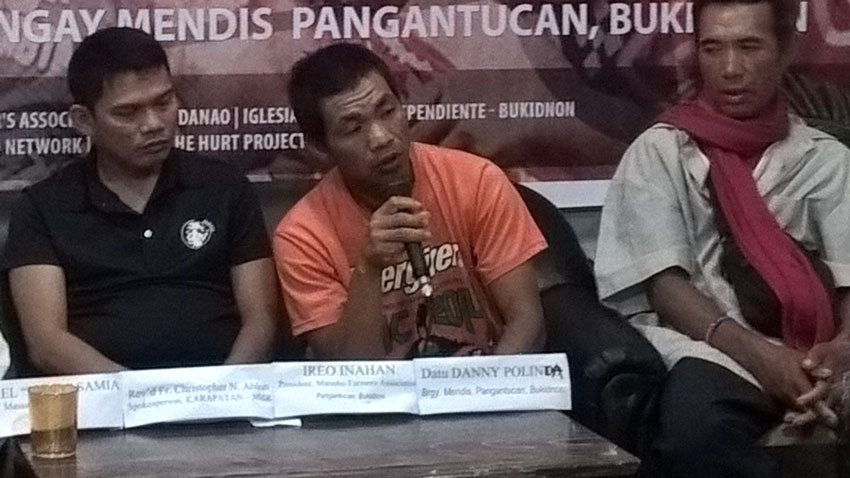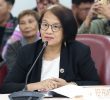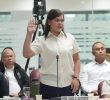
(From left) The 15-year old survivor (not shown), and son of one of the victims during the killing of five alleged rebels in Pangantucan,Bukidnon, Herminio Samia, appears before the members of the press to tell how the Army killed his family last August 18. He is joined by Fr. Christopher Ablon, spokesperson of Karapatan, Ireo Inahan, president of the Manobo Farmers’ Association and Datu Danny Polinda from BarangayMendis. (Photo contributed by Ron Clarion)
MANOLO FORTICH, Bukidnon — Whenever the state forces are accused of killing civilians there seems to be a default justification always put forward in defense of killings: “It was an encounter”.
The most recent case took place on August 18 in the municipality of Pangantucan province of Bukidnon.
The military is quick to insist that it was an “encounter” with members of the New People’s Army, while the family cries “massacre” over the death of five Lumad individuals in Sitio Mandum, Barangay Mendis, Pangantucan Bukidnon.
On August 19, the residents were shocked as they saw five dead bodies who they identified as Emer Somina, Ramil Somina, Norman Samia, Herminio Samia and Jobert Samia. In a fact-finding mission participated by various groups led by human rights group Karapatan Northern Mindanao, two weeks after the incident, community residents revealed that the five people killed were all relatives and acknowledged they were residents of the said community.
No police documentation of the scene
At around 5:00 pm on August 18 the Philippine National Police Pangantucan responded to a report about gunfire in Barangay Mendis.
Police Officer 3 Benjamin Aguilar of Pangantucan Police Station said that when they arrived, they saw some residents coming out of their houses to tell about the gunfire they heard, which started at around 4 pm. However, the police team decided not to go to the site of the incident.
When asked how far they have reached, Aguilar said “Didto pa sa ubos sa tiilan sa barangay kay layo man tong area sir, dili gyud sya proper nga barangay gyud ba. Isa pa kanang giingon nga buto-buto gyera na man gyud siguro na, murag dili na ta kaadto ana didto.”
(We only reached the base of the barangay because the area is too far, it is a remote barangay. And gunfires mean there’s a clash, so we could not go there anymore.)
No one from the police was able to document from where exactly the incident happened. The police did not go to the site to find and collect evidence that would illuminate what really transpired.
Meanwhile, Bukidnon Crime Laboratory Office headed by Police Chief Inspector Ellen Varacion-Avanzado said that on August 19 at around 12:00 in the afternoon, they departed on-board a helicopter going to the site. Unfortunately due to bad weather they were not able to proceed and instead, they went back to Camp Bahian, Malaybalay City, where they underwent briefing before the operation.
“Wala mi nakaabot sa site kay ang weather dili man makalusot ang chopper. Kay mountainous man kaayo ang area. Natagbuan namo ang mga clouds kay ulan naman. So nibalik mi. Ang instruction sa amo-a proceed mo sa Lao-as Funeral Homes kay didto dal-on ang patay,” said Varacion-Avanzado.
(We were not able to proceed because of the weather condition. The area is mountainous and we encountered clouds since it was raining. So we went back. The instruction was for us to proceed to Lao-as Funeral Homes where the bodies will be brought).
She clarified that it was Air Force’s decision to stop the operation.
Despite the absence of scene investigation, Pangantucan police came up with an investigative report describing the incident as a firefight or encounter.
Did the police come up with a conclusion too early?
According to PO3 Aguilar they based the conclusion of their investigative report on the following:
- Reports from civilians that they heard gunfire
- Two wounded soldiers
- Intelligence report received by the local police chief
- Paraffin Test Result
- Items presented by the military and the dead bodies
No one among the civilians from whom the report of gunfire came from have witnessed the incident. PO3 Aguilar also said that he was not able to talk to the two wounded soldiers and they relied on the items presented by the military as evidence.
Result of paraffin test
As per request of the Pangantucan Police Station, the Bukidnon Provincial Crime Laboratory conducted a paraffin test on the five bodies. The five persons turned out to be positive in the gunpowder residue analysis. Specifically, they produced findings that four of the killed Lumads contained gunpowder nitrates in both hands, while one of them contained gunpowder nitrates in one hand.
But the test has limits. As a scientific procedure, the test cannot go beyond its parameters. The objective of paraffin test is to determine the presence of gunpowder nitrates.
While the five bodies turned to be positive in gunpowder test, the test cannot determine how the gunpowder ended up on their hands. Whether or not the five Lumads fired a gun cannot be established through the test.
Police Chief Inspector Avanzado, who conducted the test, explained “Ang manner how the gunpowder ended up in their hands dili na nako concern, ang ako lang I have to check for the presence of gunpowder nitrates.”
(The manner of how the gunpowder ended up on their hands is beyond my concern, my job is to check for the presence of gunpowder nitrates.)
“Basta ang paraffin test can only be used as corroborative evidence dili sya kumbaga physical evidence. Mo-corroborate lang sa statements. So naa na sa court asa nga statement iyang tan-awon nga katuohan,” she said.
(The paraffin test can only be used as a corroborative evidence and it is not a physical evidence. It can only corroborate the statements and it is up to the court to determine which statement is believable).
“There is a possibility nga nagpabuto sila pero there is also a possibility nga wala sila nagpabuto,” Avanzado said.
(There is a possibility that they fired a gun but there is also a possibility that they did not fire a gun.)
Lone survivor
A 15-year old boy who survived turned up to tell what he saw on that day. The boy said one of the five people killed, Herminio, is his father and Norman and Jobert, are his brothers.
He narrated that at that time they were cooking corn for lunch, soldiers suddenly came. They were ordered by the soldiers to come out of their house and raise their hands.
The boy said that he had to accompany his father as they go out of their house since his father has blurred vision. He cannot determine the number of soldiers, but he said they were many.
He said he pleaded with the soldiers to spare them and take them as prisoners instead. However, the military did not listen. The boy said he saw his father die before his very eyes.
“Pagkakita nako nga gipusil akong papa nidagan dayon ko. Wala ko kabalo sa nahitabo sa uban’ (After I saw my father was shot I ran quickly. I do not know what happened to the others),” he recounted.
Army says victims died in an encounter
Col. Jessie Alvarez, commander of the 403rd Brigade Philippine Army brushed aside the claims of the relatives and human rights advocates that the five individuals were civilians who work as farmers. Alvarez maintained that no massacre took place.
“They died during a legitimate encounter between government and New People’s Army,” he said.
To back its claim, the military presented the result of the paraffin test conducted by the Bukidnon Provincial Crime Laboratory together with other evidence.
“All evidence and results speak for itself. The wounding of our soldiers is clear evidence that there was an encounter,” said Alvarez.
In an interview with Police Superintendent April Carbajal Madrono of the Regional Crime Laboratory Office 10 she said that the paraffin test “cannot determine if there was an encounter”.
“When you say there is an encounter, there are many elements to consider, not only the paraffin test,” said Madrono
Madrono said other elements include intelligence report, evidence that may be present and previous cases where these people may be involved.
Evidences
The military said that during the encounter two soldiers were wounded and they recovered one AK47 rifle, 19 backpacks containing medical supplies, food, personal belongings and subversive documents.
Lt. Col. Nasser Lidasan, commander of the 1st Special Battalion said that they only recovered one firearm since the fleeing rebels took the other firearms of their dead comrades.
The rebels they encountered according to Lidasan belongs to NPA’s Guerilla Front Committee 68 under Lesis Micabalo a.k.a “Commander Bagwis”.
However, P/Supt Madtrono said the evidence were not submitted to the PNP.
“Kung naay nakakita it should be delivered to us for examination (When someone finds an evidence it should be delivered to us for examination),” said Madrono.
As part of the standard procedure the items recovered from the scene must be examined by the PNP Crime Laboratory (PNP CL) to determine if there are indications that could establish links between the weapon and the killed Lumads the military accused of being members of the NPA.
As to the question, where are the items are, Avanzado said “I don’t know where they submitted the firearms. I am certain nothing has been delivered to us from the Army”.
When the bodies arrived in the funeral home, the Scene of the Crime Operatives (Soco) team recovered a backpack containing six 12 gauge cartridges and two misfired 12-gauge cartridges and P530 cash from Cadaver 1.
On the other hand, PO3 Aguilar, who accompanied the bodies to a hospital in Maramag before they were transported to a funeral home in Valencia City, admitted that he had not discovered any items from the bodies when he saw them in the hospital.
“Wala mi kabalo at that time nga kadto lagi kadtong gi-claim nila nga tigulang na, wala mi kabalo nga at that time naa to syay bala (We did not know that the person they claim to be as the old man has ammunitions),” he said.
Mission report
The fact-finding mission report contained accounts of residents who saw the dead bodies on the 19th of August.
An excerpt of report says:
“They (residents) saw that their neighbors showed signs of torture. Emer, who lay face-up, still had his arms above his head. There was a bullet wound on his leg and his throat slit. Norman, the youngest of the victims, was also lying face-up, the right half of his head blown – his right ear had been torn off. Ramil was also lying face-up, his right hand was chopped off, and his throat was also slit. Jobert had both his legs shot, and his throat slit. Hermenio was the only one not in the line, his body near their coffee trees. His stomach was torn, and his throat was also slit.”
In the post-mortem processing conducted by the Bukidnon Crime Laboratory, Chief Inspector Avanzado told us since there was no doctor at the time; no one is in the right position to determine what types of wounds they sustained.
However, she said that there were different kinds of wounds located in different parts of the body.
Since no one can identify the bodies, Avanzado only referred to the five bodies as Cadaver 1, Cadaver 2, Cadaver 3, Cadaver 4 and Cadaver 5. She also used the generic term “wounds” in reference to the injuries found in the bodies.
In a separate interview with Ramon Ballon, the owner of Lao-as Funeral Homes, where the bodies were taken, said the bodies were already decomposing when they arrived.
He said the bodies arrived at around 5:00 pm on August 19 and were transported by a dump truck from the local government unit of Pangantucan together with the police.
Ballon said he “could not tell whether their injuries are from gunshot wounds.”
Ballon said that they carried out the embalming service as soon as the post-mortem processing was finished. The procedure entails running up stitches on the wounds found in different parts of the body.
Chief Inspector Avanzado also said she “thinks” the Army decided for the embalment of the bodies.
“I think the Army was the one who made the arrangement,” she said.
While the PNP Crime Laboratory strongly encourages the conduct of an autopsy to establish the cause of death, Avanzado said that since the wounds were already fixed by stitches, that could have implication on the result of the autopsy.
The families together with human rights advocates condemn the killings. Fr. Christopher Ablon of Karapatan Northern Mindanao calls for the investigation and persecution of the perpetrators.
In their report, they recommended the pull out of military troops from Barangay Mendis. They call for indemnification of the families of the victims and the community. (davaotoday.com)










